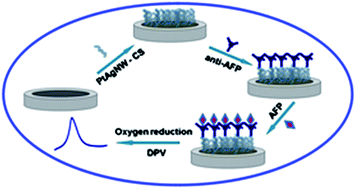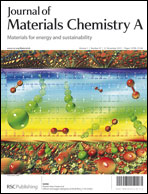PtAg nanowires: facile synthesis and their applications as excellent oxygen reduction electrocatalysts for label-free electrochemical immunoassay
Abstract
Bimetallic PtAg nanowires (PtAgNWs) were synthesized through a water-based mild chemical route for the first time. Due to their high conductivity, large surface area, and synergistic electronic effects of the alloyed Pt–Ag atoms, the obtained catalysts exhibited considerably high oxygen reduction activities. This unique catalytic property along with desired functionalities and surface charge characteristics provide interesting platforms for interfacing signal amplification. A novel label-free electrochemical immunosensor for ultrasensitive detection of alpha-fetoprotein (AFP) was then developed based on bimetallic PtAgNW catalyzed oxygen reduction for signal amplification. Under optimal conditions, the amperometric signal decreases linearly with AFP concentration (0.001–36 ng mL−1), resulting in a low limit of detection (0.2 pg mL−1). Satisfactory results were demonstrated concerning the application of the novel immunosensor for the detection of AFP in real samples.


 Please wait while we load your content...
Please wait while we load your content...